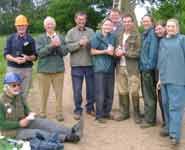
From left to right: Colin Morris, a licensed bird ringer; Barry Gray, Hawk and Owl Trust; Graham Guest, Hawk and Owl Trust; Keith Latham, Hawk and Own Trust; Nicola Hugenholtz, vet student; Mike Jones, Farm Manager; Jeff Sharpe, Farm staff; Isobel Agnew, vet student; Lauren Smith, vet student and Pippa McAinsh, vet student
Press release issued:
22 June 2010
Earlier this month four kestrel chicks were discovered in a nesting box on the University’s Wyndhurst Farm, which is one of the sites for the Hawk and Owl Trust's "Kestrel Highways project".
A farm in North Somerset has had some surprise arrivals and not the usual four-legged kind.
Wyndhurst Farm, part of the University of Bristol's Department of Clinical Veterinary Science, is participating in the Hawk and Owl Trust's "Kestrel Highways project", in which nesting boxes are erected alongside various roads.
Earlier this month a team from the Trust visited the nesting box on Wyndhurst Farm and discovered four kestrel chicks, which a licensed fieldworker proceeded to ring and register.
Michael Jones, Farm Manager of Wyndhurst Farm, said: "We are delighted to be taking part in the "Kestrel Highways project" and were thrilled to find chicks in our nesting box.
"Apparently, ours are the only successful births in the boxes the Trust has put up along the A38 between Bedminster Down and Bridgwater."
The project hopes to establish whether providing nestboxes in suitable feeding habitat will help reverse the falcon's population slump.
The kestrel is an iconic bird for motorists as it hovers above the rough grassland on roadside verges, looking for prey.
It is, however, no longer the most common bird of prey in the UK. The buzzard is now the most common bird of prey, with kestrels having declined by a fifth between 1994 and 2005.
Further information
The
Hawk and Owl Trust is a national charity, working for wild birds of prey and their habitats.
By the beginning of 2010 Hawk and Owl Trust volunteers had put up kestrel nestboxes along the following stretches of road:
ENGLAND
A24, Worthing through Low Weald Area, West Sussex
A303, Mere to Amesbury, Wiltshire
A38, Bedminster Down, Bristol to Bridgwater, Somerset
A38, Alveston to Hardwicke, Gloucestershire
B4058, Frampton Cotterell to Wotton-under-Edge, Gloucestershire
A148, Felbrigg Hall to Little Snoring, Norfolk
A171, Harwood Dale to Robin Hood's Bay, North Yorkshire
B1416, from A171 to Sneaton Moor, North Yorkshire
WALES
A40/A465, Abergavenny, Monmouthshire, to Longtown, Hereford
SCOTLAND
A75, Newton Stewart to Gatehouse of Fleet, Dumfries & Galloway
